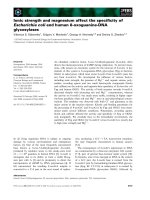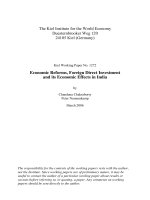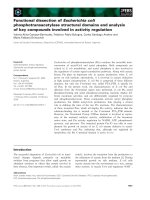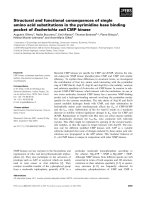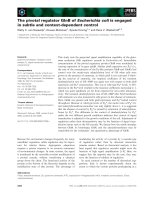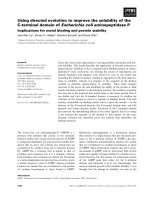Occurrence and seasonal variation of Escherichia coli isolated from unpasteurised raw milk and its products sold in Abuja Metropolis, Nigeria
Bạn đang xem bản rút gọn của tài liệu. Xem và tải ngay bản đầy đủ của tài liệu tại đây (250.25 KB, 10 trang )
Int.J.Curr.Microbiol.App.Sci (2019) 8(5): 1979-1988
International Journal of Current Microbiology and Applied Sciences
ISSN: 2319-7706 Volume 8 Number 05 (2019)
Journal homepage:
Original Research Article
/>
Occurrence and Seasonal Variation of Escherichia coli Isolated from
Unpasteurised Raw Milk and its Products Sold in
Abuja Metropolis, Nigeria
E.C. Okechukwu1*, E.U. Amuta2, G.M. Gberikon1 and M. Njoku3
1
Department of Microbiology, 2Department of Zoology,
Federal University of Agriculture, Makurdi, Nigeria
3
Department of Microbiology and Biotechnology,
National Institute for Pharmaceutical Research and Development, Abuja, Nigeria
*Corresponding author
ABSTRACT
Keywords
Escherichia coli,
Unpasteurised raw
milk, Milk
products, Hygiene,
Sanitary conditions
Article Info
Accepted:
17 April 2019
Available Online:
10 May 2019
Raw milk and milk products are traditional staple diets that are popularly consumed by
both rural and urban population of Northern Nigeria and many other parts of Africa. The
aim of the study was to isolate E. coli from unpasteurised raw milk and milk products
(Madara, Kindrimo, Nono and Manshanu) during the rainy and dry seasons in Abuja in
order to ascertain the hygienic status of the dairy products. Three hundred unpasteurised
raw milk and its products were collected in both rainy and dry seasons respectively.
Escherichia coli was isolated by microbiological techniques and confirmed by
Microbact™ (Oxiod™) GNB 24E System Identification Kit. Results showed that dry
season had higher occurrence of E. coli (21, 7.0%) while occurrence during rainy season
was (14, 4.7%). There was no statistically significant difference in occurrence of E. coli
isolates during the two seasons (p> 0.05). These ready to eat dairy products frequently
harbor coliforms that indicates poor hygiene and insanitary conditions possibly during
processing and cause infections that are of great public health importance. Educating the
milk handlers on the importance of personal hygiene and proper sanitary methods is
necessary.
Introduction
Consumption of fresh produce is part of a
healthy diet, but pathogen contamination of
fresh produce has resulted in serious public
health consequences (Jung et al., 2014).
Globally, the number of outbreaks and cases
of foodborne illness associated with
consumption of contaminated food continues
to escalate (Teplitski et al., 2011; Hoelzer et
al., 2012). Marketers and consumers of
unpasteurised raw milk and their products
have existed in many parts of the world.
Unpasteurised raw milk is consumed directly
by a large number of people in rural areas and
indirectly by a much larger segment of the
population by consuming the raw milk and its
products. Reasons that people may believe
1979
Int.J.Curr.Microbiol.App.Sci (2019) 8(5): 1979-1988
that the raw milk and their products have
beneficial dietary effects and additional
nutritive value over the pasteurised one (Ali
and Abdelgadir, 2011).
Raw milk and milk products of dairy cattle
are known repository of food borne pathogens
(Enabulele et al., 2014). The presence of food
borne pathogens in milk has been traced to
direct contact with contaminated sources in
the dairy farm environment particularly from
water source, and excretion from the udder of
an infected animal (Oliver et al., 2005).
Contamination of milk and milk products,
with pathogenic bacteria is largely due to
processing, handling, and utensils used for the
storage of milk on farm or during
transportation and unhygienic conditions.
Nono, Kindrimo, Manshanu and Madara are
local dairy products that are widely consumed
as food especially in the northern part of
Nigeria, and these have been reported to
contain high nutritional values (Makut et al.,
2014). Escherichia coli which belongs to the
Enterobacteriaceae family, is a Gramnegative,
facultative
anaerobic,
nonsporulating bacteria. It is widely distributed in
intestinal microbiota of humans and warmblooded animals and in the environment,
when contaminated with feaces (Nataro and
Kaper, 1998; Smith et al., 2004).
Escherichia coli and other coliforms are
microbes that can easily contaminate milk and
milk products, which are often used as
indicator organisms. The recovery and
remuneration of E. coli is used as reliable
indicator of feacal contamination and
indicates
a
possible
presence
of
enteropathogenic
and/or
toxigenic
microorganisms which constitute a public
health hazard.
Most E. coli are harmless, but a substantial
population is known to be pathogenic
bacteria, causing severe intestinal and extra
intestinal diseases in man (Kaper et al., 2004).
Owning to the fact that these ready-to-eat
dairy products are processed by ‘too simple’ a
method and the knowledge on the microbial
limit especially the coliforms is barely
unknown. There are scanty reports on the
microbiological quality of milk and its
product in Nigeria. The aim of the study was
to
determine
the
presence
of
Enterobacteriaceae, Escherichia coli a
coliform as an indicator of unsanitary
practices in food during the two major
seasons of the year.
Materials and Methods
Sample location
The study was carried out in Abuja, the
Federal Capital Territory (FCT) located in the
geographical Centre of Nigeria with a land
area of 8, 000 square kilometres and lies
between latitude 9° 10' north of the equator
and longitude 7° 11' east. It is bounded North
by Kaduna state (North), Niger state (West),
Nasarawa state (East) and Kogi state (South)
(Dawam, 2000). It is made up of six Area
Councils namely, Abaji, AMAC (Abuja
Municipal
Area
Council),
Bwari,
Gwagwalada, Kuje and Kwali. The study area
experiences two weather conditions annually
which are the rainy season and the dry season.
The rainy season begins from April and ends
in October and the dry season from November
and ends in March (Abdulmalik et al., 2013).
Sample collection
Three hundred (300) milk samples were
randomly collected from the six Area
Councils at various points in dry and rainy
seasons
respectively.
Samples
were
aseptically collected in duplicates at point of
sales in sterile plastic containers, labeled and
transported in ice box to the laboratory for
immediate analysis.
1980
Int.J.Curr.Microbiol.App.Sci (2019) 8(5): 1979-1988
Microbiological
analysis/
sample
enrichment, selective and differential
plating
procedure were followed as prescribed by
Cowen and Steel (1977), Balows et al.
(1991).
Ten millilitres (10ml) of the unpasteurised
raw milk samples were transferred into 90ml
of modified Tryptic Soy broth (mTSBn)
(oxoid)
supplemented
with
20mg/l
novobiocin
(oxoid)
homogenized
for
2minutes in a stomacher (Lab Blender 400,
Seward Medical, London, UK) and then
incubated at 370C for 18 hours as E. coli
enrichment step. A loopful of the enriched
broth was streaked on the plate of Eosin
Methylene blue agar (EMB), (oxoid) and after
overnight incubation at 370C. Suspected
colonies of E. coli (greenish metallic sheen
appearance with dark purple centres) were
Gram stained, biochemically identified and
confirmed.
Statistical Analysis
Biochemical
Escherichia coli
characterization
of
The presumptive Gram stained E. coli were
subjected to conventional biochemical tests
namely,
Gelatin
liquefaction,
Nitrate
reduction, Urease production, Oxidase,
Indole-methylred-Voges-Proskauer, Catalase,
Citrate Agar, and Sugar fermentation tests
(Müller et al., 2003).
Confirmatory screening of presumptive E.
coli MICROBACT™ GNB 24E system
identification
Confirmatory screening was carried out on
the presumptive Gram stained E. coli isolates
using MICROBACT™24E. The isolates were
subsequently
confirmed
using
the
commercially prepared biochemical test kits
(Microbact Oxoid). The MICROBACT™
identification kits (Oxiod) were inoculated
with the E. coli suspension, incubated at 370C
for 18-24hours and results read as described
by the manufacturer. The steps of the
The data generated in this study was analyzed
by Chi Square test using SPSS version 20.0.
The value of (p<0.05) was considered
statistically significant.
Results and Discussion
The percentage occurrence of E. coli during
the dry season (Table 1), was (21, 7.0%). The
highest percentage occurrence among the four
milk types was Madara (10, 14.3%), followed
by Kindrimo (6, 6.7%), Nono (3, 3.8%) and
Manshanu (2, 3.3%). Though the percentage
occurrence of E. coli in the milk samples
differed during the dry season, there was no
statistically significant difference (χ²= 7.381,
df= 3, P=0.061) in the occurrence of E. coli
during the dry season. This indicates that dry
season did not affect the growth of
Escherichia coli at the period of this study.
Table 2 shows the percentage occurrence of
E. coli during the rainy season (14, 4.67%).
Madara had the highest percentage of
occurrence (5, 6.02 %), followed by Kindrimo
(4, 5.7%), Nono (3, 3.9%) and Manshanu (2,
2.9%). Though, there seemed to be varying
percentages of occurrence of E coli in the
different milk samples, there was no
statistically significant difference (χ²= 1.429,
df= 3, P= 0.699) in the occurrence of E. coli
during the rainy season, which indicates that
rainy season did not affect the survival and
growth of Escherichia coli in the milk
products at the time of this study.
Figure 1 displays the overall distribution of E.
coli in the two seasons (dry and rainy season),
from the four milk products. Madara had the
highest occurrence in the dry season (10,
1981
Int.J.Curr.Microbiol.App.Sci (2019) 8(5): 1979-1988
14.3%) and highest in the rainy season (5,
6.0%) and total of (15, 9.8%) followed by
Kindrimo (6, 6.7%) in the dry season and (4,
5.7%) in the rainy season with total of ( 10,
6.3%), Nono had (3, 3.8%) in the dry season
and (3, 3.9%) in the rainy season with total of
(6, 3.8%) while Manshanu had the lowest
occurrence of E. coli (2, 2.9%) in the dry
season and (2, 3.3%) in the rainy season with
total of (4, 3.1%).
2000). Previous studies suggested that raw
milk and various dairy products samples were
considered to be the primary source of E. coli
(Gundogan and Avci, 2014; Abebe et al.,
2014).The production of these milk products
is based on traditional methods (bare hands)
without any regard to the quality of raw
materials used and the safe quality of the
products (Soomro et al., 2002; Campos et al.,
2009).
Unpasteurised raw milk and milk products are
nutrient rich sources of food (Momtaz et al.,
2012; Egwaikhide et al., 2014; Igwegbe et al.,
2015) and has become a significant part of
human diet (Igwegbe et al., 2015). The
complex composition and water activity of
raw milk (Soomro et al., 2002), which makes
it a favourable medium that supports the
growth
and
survival
of
various
microorganisms (Mohamed and El-Zubeir,
2007) either pathogenic or non-pathogenic
strains which may result in desirable and
undesirable products in the milk (Yagoub et
al., 2005; Ogbonna et al., 2012) or may cause
infections and intoxications in humans when
consumed (Oliver et al., 2005).
In developing countries, it is difficult to
secure optimal food hygienic practices
(Abebe et al., 2014), and under such
prevailing conditions microorganisms gain
entry into the milk and its products. One of
such microorganisms is Escherichia coli.
Escherichia coli is an environmental pathogen
(Caine et al., 2013), a frequently
contaminating organism, and is a reliable
indicator of feacal contamination generally in
insanitary conditions and poor hygiene of
water, food, milk and other dairy products
(Diliello,1982; Thaker et al., 2012). The
status of Escherichia coli as pathogen and its
presence in food constitutes public health
concern (Caine et al., 2013).The recovery of
E. coli from unpasteurised raw milk and milk
products samples in this study agrees with
reports of other researchers (Adesiyun et al.,
1997; Onono et al., 2010; Ali and Abdelgadir,
2011; Rahimi, 2011; Cain et al., 2013;
Enabulele et al., 2014; Gundogan and Avci,
2014; Makut et al., 2014).
Several researchers have reported on the poor
microbiological quality of unpasteurised raw
milk, tracing the contamination of these milk
and milk products to some factors such as
unhygienic practices of the milkers/handlers
(Soomro et al., 2002; Abebe et al., 2014),
insanitary vessels/utensils for storage and
temperature (Leedom, 2006; Campos et al.,
2009; Momtaz et al., 2012), environment and
infected milk producing animals(Momtaz et
al., 2012; Caine et al., 2013; Jeyakumar and
Lawrence, 2014), and contaminated water
(Abdalla and El-Zubeir, 2006; Momba et al.,
2008). Escherichia coli is one of the most
frequently encountered microorganisms in the
food industry (Adeferekan et al., 2014).
Various disease outbreaks have been reported
to be due to ingestion of food contaminated
with pathogenic E. coli strains (Pradel et al.,
It also suggested that the methods of
production, handling during processing,
transportation and sales of these ready-to-eat
food are entirely insanitary thereby exposing
the milk samples to microbial contamination
(Ali and Abeldagir, 2011). The nosedive in
the aspect of sanitary practices could cause
food borne diseases (Ijah et al., 2002),
especially among urban residents who drink
fresh milk sold by the Fulani women (Okeke
et al., 2014). The presence of bacterial
contamination of raw milk and milk products
1982
Int.J.Curr.Microbiol.App.Sci (2019) 8(5): 1979-1988
especially by coliform, Enterobacteriaceae
particularly E. coli have been evaluated and
reported by several researchers (Soomro et
al., 2002; El-Zubeir and Ahmed 2007; Ali and
Abdelgadir 2011; Momtaz et al., 2012;
Ogbonna et al., 2012; Caine et al., 2013;
Abebe et al., 2014; Vendramin et al., 2014;
Al-Zogibi et al., 2015; Enem et al., 2015;
Mohammed and Abdullahi, 2015; Saba and
Adzitey, 2015).
The presence of E. coli indicates that the
control of raw material manufacturing
processes and the final product is inefficient
(Campos et al., 2009). Escherichia coli is a
frequently occurring microorganism in milk
and milk products. This implies that the
microbial contamination of these milk and its
products is not far-fetched from the
predisposing factors such as the insanitary
conditions, unhygienic state of the milkers,
insects and dusts (Momtaz et al., 2012; Abebe
et al., 2014).
Several findings from different researchers
showed high prevalence of E. coli in raw
milk; Saba and Adzitey (2015) (49.3%) in
Ghana; Abebe et al., (2014) (26.6%) in
Ethiopia; Ali and Abdelgadir (2011), (63%) in
Sudan; in Turkey, Gundogan and Avci,
(2014) (74%); in Brazil, Vendramin et al.,
(2014) (53.5%); (Campos et al., (2009)
(79.2%); Meshref (2013) (52.6%) in Egypt;
Thaker et al., (2012) (30%) in India; Mailafia
et al., (2017) (27.3%) in Abuja, Nigeria;
Caine et al., 2014 (45%) in South Africa;
Shah et al., (2016) (33.3%) in Malaysia.
This is an indication that the presence of E.
coli in raw milk provides evidence that
unpasteurised raw milk could be a vehicle of
transmission of food borne pathogens
possibly
carrying
enterohaemorrhagic/
enteropathogenic
and/or
toxigenic
microorganisms which could constitute a
public health hazard (Ali and Abdelgadir,
2011).
Abebe et al. (2014) reported that raw milk is a
vehicle and medium of growth for E. coli.
The presence of E. coli implies a risk that
other enteric pathogens may be present in the
food samples (Meshref, 2013). According to
Meshref (2013), raw milk is the basic material
from which all dairy products are made. The
diversity of microorganisms and the level of
contamination in the raw material have a
decisive effect on the quality and safety of the
final product.
Several factors could be responsible for the
contamination of raw milk with E. coli
namely the use of contaminated utensils, use
of contaminated water, milk contact surfaces,
contamination of milk with feaces, improper
storage conditions, unhygienic milking
equipments, milking enviroment (El-Zubeir
and Ahmed, 2007), dirty hands (Bagréet al.,
2014), infected animals (El-Zubeir et al.,
2006) and storage and transport equipment
(Altalhi and Hassan, 2009; Bityqi et al.,
2011). Therefore, the implication of the
presence of food borne pathogen in
unpasteurised raw milk is that there is a high
risk of ingestion of potentially harmful toxins
and transmission of food-borne pathogens
(Ali and Abdelgadir, 2011).
The result of this study showed higher
occurrence of the E. coli in the dry season
than during the rainy season. This finding
corroborates with the reports of El- zubeir and
Ahmed (2007) that higher bacterial counts are
expected under tropical condition due to the
fact that high temperatures enhances growth
and multiplication of bacteria. Soomro et al.,
(2002) in Pakistan reported that raw milk is
easily contaminated due to high ambient
summer temperatures.
1983
Int.J.Curr.Microbiol.App.Sci (2019) 8(5): 1979-1988
Table.1 Frequency of occurrence of E. coli isolates from unpasteurised
raw milk samples during dry season
Sample Type
No. Screened
No. Positive
% Positive
Madara
Kindrimo
Nono
Manshanu
Total
70
90
80
60
300
10
6
3
2
21
14.3
6.7
3.8
3.3
7.0
(χ2= 7.381, df=3, P=0.061)
Table.2 Frequency of occurrence of E. coli isolates from unpasteurised raw milk samples during
rainy season
Sample Type
No. Screened
No. Positive
% Positive
Madara
Kindrimo
Nono
Manshanu
Total
83
70
77
70
300
5
4
3
2
14
6.0
5.7
3.9
2.9
4.7
(χ2= 1.429 df=3, P=0.699)
Madara
Fig.1 Relative percentage distribution of E. coli in rainy and dry seasons in unpasteurised raw
milk samples
1984
Int.J.Curr.Microbiol.App.Sci (2019) 8(5): 1979-1988
In conclusion, the study has shown that
unpasteurised raw milk and its products are
not without microbial contamination. As a
developing country, perhaps in this part of the
globe there are no established acceptable
microbial limits in dairy products. With the
growing concerns over the hygienic status of
ready-to-eat food, the government should be
proactive in monitoring food of bovine origin
especially the dairy products that are
consumed without necessarily cooking and
ensuring effective food surveillance programs
in order to monitor locally made food
especially produced from animal origin that
are readily available to the populace.
Recommendation
Preventive measures such as regular hand
washing and sterilization of dairy equipment,
utensils, milker's hands, animal udders, and
eradication of diseased animals from the herd
are highly recommended. The reduction of
faecal contamination in milk production to its
barest minimal load is the key to control this
pathogen in dairy farms.
References
Abdalla, M.E.M. and. El-Zubeir, I.E.M. (2007).
Effects of different management practices
on milk hygiene of goat farms in
Khartoum State, Sudan. International
Journal of Dairy Sciences, 2: 23-32.
Abdulmalik, R.O, Oyinbo, O., and Sami, R. A.
(2013). Determinants of Crop Farmers
Participation in Agricultural Insurance in
the Federal Capital Territory, Abuja,
Nigeria. Greener Journal of Agricultural
Sciences 3 (1): 021-026
Abebe M. Hailelule, A. Abrha, B., Nigus A.,
Birhanu M., Adane H., Genene T. Daniel
H. Getachew, G. Merga and Haftay A.
(2014) Antibiogram of Escherichia coli
strains selected from food of bovine
origin selected in Woredas of Tigray,
Ethiopia. Journal of Bacteriology
Research, 6(3): 17-22
Adefarakan, T. A., Oluduro, A. O., David, O.
M., Ajayi, A. O., Ariyo, A. B., and
Fashina, C. D. (2014). Prevalence of
antibiotic resistance and molecular
characterization of Escherichia coli from
faeces of apparently healthy rams and
goats in Ile-Ife, Southwest, Nigeria. Ife
Journal of Science 16 (3)
Adesiyun, A.A., Webb, L.A. Romain, H. and
Kaminjolo, J.S. (1997). Prevalence and
Characteristics of Strains of Escherichia
coli Isolated from Milk and Feces of
Cows on Dairy Farms in Trinidad.
Journal of Food Protection 60 (10) 174118.
Ali, A. A. and Abdelgadir, W.S. (2011).
Incidence of Escherichia coli in Raw
Cow's Milk in Khartoum State. British
Journal of Dairy Sciences 2(1): 23-26,
2011.
Altalhi A.D., Hassan S.A. (2009). Bacterial
quality of raw milk investigated by E. coli
and isolates analysis for specific virulence
-gene markers. Food Control; 20: 913–
917.
Al-Zogiby, G. O., Mohammed, M.I., Hessain,
M.A., El-Jakee, J.K. Kabli, S.A (2015)
Moleccular
and
serotyping
characterization of shiga toxigenic
Escherichia coli associated with collected
from Saudi Arabia. Saudi Journal of
Biological Sciences (22) 438-442
Bagré, T.S., Kagambèga, A., Bawa, H.I.,
Tchamba, G.B., Dembélé, R.E., Zongo,
C., Savadogo, A., Aggad, H., Traoré, A.S.
and Barro, N. (2014). Antibiotic
susceptibility of Escherichia coli and
Salmonella strains isolated from raw and
curds milk consumed in Ouagadougou
and Ziniar, Burkina Faso. African Journal
of Microbiology Research 8(10), 10121016.
Balows, A., Hausier W.J., Hermann K.L.,
Isengeng, J.D. and Shadomy, J. H. (eds)
(1991) Manual of Clinical Microbiology,
5th Edition, American Society of
Microbiology, Washington D.C.
Bytyqi, H., Bigler, S., Muji, S., Jahja, A.,
1985
Int.J.Curr.Microbiol.App.Sci (2019) 8(5): 1979-1988
Zaugg, U. (2011) Survey on raw milk
quality in Kosovo. Food and Nutrition
Science 2011; 2: 414–421
Caine, L., Pekana, A., Lukanji, Z., Idamokoro,
M., and Green, E. (2013) Pathogenic
Escherichia coli strains in raw milk
obtained from two farms of the Eastern
Cape Province, South Africa. Mendel Net
Campos, M.R.H., André, M.C.D.P.B., Borges
L.J., Kipnis A., Pimenta, F.C., Serafini,
A.B. (2009) Genetic heterogeneity of
Escherichia coli strains isolated from raw
milk, Minas Frescal cheese, and food
Arq. Bras. Med. Vet. Zootec., 61(5):
1203-1209,
Cowen, S. T. and Steel K.J. (1977) Manual for
the identification of Medical Bacteria, 2nd
Edition Cambridge University.
Dawam, P.D. (2000) Geography of Abuja
Federal Capital Territory. Famous and
Ansala Publishers, Minna.
Diliello, L.R., (1982) Methods in Food and
Dairy Microbiology. AVI Publishing Co.
Inc. Westport Connt. USA: pp39
Egwaikhide, P. A., Malu, P. S., Lawal, U.,
Adelagun, R. O and Andrew, C. (2014).
Physico-Chemical and Microbiological
Analysis of Fermented Cow Milk (Nono)
Consumed Within Kaduna Town, NorthWestern Nigeria. Food Science and
Quality Management 29
El Zubeir, I. E. M. and Ahmed, M. I. A. (2007)
The Hygienic Quality of Raw Milk
Produced by Some Dairy Farms in
Khartoum State, Sudan. Research Journal
of Microbiology, 2: 988-991.
El-Zubeir, I.E.M., Kutzer, P. and. El-Owni,
O.A.O. (2006). Frequencies and antibiotic
susceptibility patterns of bacteria causing
mastitis among cows and their
environment in Khartoum state. Research
Journal of Microbiology 1: 101-109.
Enabulele, S.A., Eghafona, N.O. And Dahiru,
M. (2014) Molecular Characterisation
And Verotoxigenic Potentials Of
Enterohaemorrhagic Escherichia coli
0157:H7 isolated from fermented fresh
cow milk (Nunu) sold in selected cities in
Nigeria. Journal of Basic and Applied
Sciences 1(1): 51 – 62, 2014.
Enem, S.I., Oboegbulem, S.I., Nafarnda, W.D,
Omeiza G.K. (2015). Detection of
Verocytotoxigenic Escherichia coli O157
serotype in dairy products in Abuja,
Nigeria. Open Journal of Veterinary
Medicine 5, 224-228
Gundogan, N. and Avci, E. (2014) Occurrence
and antibiotic resistance of Escherichia
coli, Staphylococcus aureus and Bacillus
cereus in raw milk and dairy products in
Turkey. International Journal of Dairy
Technology, 67(4).
Hoelzer, K., Pouillot, R., Egan, K., and Dennis,
S. (2012) Produce consumption in the
United
States
–An analysis
of
consumption frequencies, serving sizes,
processing forms, and high-consuming
population subgroups for microbial risk
assessments. Journal of Food Protection
75: 328–340.
Igwegbe, A.O., Maina, F.J., Kassum, A.L.,
Agbara, G.I., Chibuzo, E.C., Badau, M.
H. (2015) Evaluation and acceptability of
yoghurt drink processed from goat milk
and a combination of goat and cow milks.
International Journal of Biotechnology
and Food Science 3(4), pp. 41-48,
Ijah J.J., Odagboyi G, Uwabujo A.E. (2002)
Microbiological screening of furan da
nono. Nigeria Journal of Science
Technology and Mathematical Education
5(1): 9-16
Jeyakumar E, and Lawrence, R. (2014).
Prevalence of multi-drug resistant (MDR)
Enteric bacteria in milk and milk
products. Indian Journal of Dairy
Science, 67.
Jung, Y., Jang, H. and Matthews, K. R. (2014)
Effect of the food production chain from
farm practices to vegetable processing on
outbreak
incidence.
Microbial
Biotechnology, 7(6), 517–527.
Kaper, J.B., J.P. Nataro and H.L.T. Mobley,
(2004). Pathogenic Escherichia coli. Nat.
Rev. Microbiology, 2: 123-140.
Leedom, J.M. (2006) Milk of non-human origin
and infectious diseases in human. Clinical
Infectious Diseases. 43, 610-615
1986
Int.J.Curr.Microbiol.App.Sci (2019) 8(5): 1979-1988
Mailafia, S., Olabode, H. O., Okoh, G., Jacobs,
C., Adamu, G. S., Onyilokwu, A. S.
(2017)
Microbact™
24E
system
identification
and
antimicrobial
sensitivity pattern of bacterial flora from
raw milk of apparently healthy lactating
cows in Gwagwalada, Nigeria. Journal of
coastal Life Medcine, 3(8): 356-359
Makut, M. D., Nyam, M. A., Amapu, T. Y., and
Abbul-Mutalib Ahmed, AM. (2014)
Antibiogram of bacteria isolated from
locally processed cow milk products sold
in Keffi metropolis, Nasarawa State,
Nigeria. Journal of Biology, Agriculture
and Healthcare, 4(4).
Meshref A M S (2013) Bacteriological quality
and safety of raw cow’s milk and fresh
cream. Slovenian Veterinary Research 50
21–30.
Mohamed, N.N.I. and. El Zubeir, I.E.M. (2007).
Evaluation of the hygienic quality of
market milk of Khartoum State (Sudan).
International Journal Dairy Sciences., 2:
33-41.
Mohammed A.S. and Abdullahi, M. (2015)
Comparative study of microbial quality of
hawked nono and packaged yogurt sold in
Bida Metropolis. Specialty Journal of
Psychology and Management Vol, 1 (0):
1-4
Momba, M.N.B., Abong’o, B.O. and
Mwambakana J.N. (2008) Prevalence of
enterohaemorrhagic Escherichia coli
O157:H7 in drinking water and its
predicted impact on diarrhoeic HIV/AIDS
patients in the Amathole District, Eastern
Cape Province, South Africa. Water
South Africa Vol. 34 (3)
Momtaz, H., Farzan R., Rahimi, E., Dehkordi
F.S., and Souod, N. (2012) Molecular
Characterization of Shiga
ToxinProducing Escherichia coli Isolated from
Ruminant and Donkey Raw Milk
Samples and Traditional Dairy Products
in Iran.
Momtaz, H., Dehkordi, F.S., Taktaz, T.,
Rezvani, A., Yarali, S. (2012) Shiga
Toxin-Producing
Escherichia
coli:
Isolated from Bovine Mastitic Milk:
Serogroups, Virulence Factors, and
Antibiotic Resistance Properties. The
Scientific World Journal 2012.
Müller, E.E., Grabow, W.O.K and MM Ehlers
M.M. (2003) Immunomagnetic separation
of Escherichia coli O157:H7 from
environmental and wastewater in South
Africa. Water South Africa (29): 4
Nataro, J.P., Kaper, J.B. (1998) Diarrheagenic
Escherichia
coli.
Clinical
Microbiological Review 1998; 11 (1):
142-201
Ogbonna, l.O., David, A.B., Waba, J.T., Eze,
P.C. (2012) Microbiological quality
assessment of biradin, kesham and
kindirmo (milk product) sold in
Maiduguri Nigeria. International Journal
of Dairy Science (1): 11-19.
Okeke K. S., Abdullahi, I. O. and Makun, H. A.
(2014) Microbiology quality of dairy
cattle products British Microbiology
Research Journal 4(12): 1409-1417.
Oliver, S.P. Jayarao B.M. and Almedia, R.A.
(2005). Food borne pathogens in milk and
the dairy environment food safety and
public health implications. Foodborne
Pathogens and Disease, 2: 1115-1129
Onono, J. O., Erastus Kiambi Kangethe, E.K.,
and Ogara, W.O. (2010) Antimicrobial
susceptibility of non-sorbitol fermenting
Escherichia coli isolated from cattle
feaces and milk samples. African Journal
of Microbiology Research 4(16), Pp.
1703-1707,
Pradel, N., Livrelli, V., De Champs, C.,
Palcoux, J. B., Reynaud, A., Scheutz, F.,
Sirot, J., Joly, B., Forestier, C. (2000).
Prevalence and characterization of Shiga
toxin producing Escherichia coli isolated
from cattle, food, and children during a
one-year prospective study in France.
Journal of Clinical Microbiology
38:1023–1031.
Rahimi, E., Chaleshtori, S.S. and Parsaei, P.
(2011) Prevalence and antimicrobial
resistance of Escherichia coli O157
isolated from traditional cheese, ice cream
and yoghurt in Iran. African Journal of
Microbiology Research 5(22), 3706-3710,
1987
Int.J.Curr.Microbiol.App.Sci (2019) 8(5): 1979-1988
Saba C.K.S., Yankey Eric and Frederick
Adzitey (2015) Prevalence of Escherichia
coli and shiga toxin producing
Escherichia coli in cattle faeces and raw
cow milk sold in the Tamale Metropolis,
Ghana. Journal Of Dairy Veterinary And
Animal Research 2 (5)
Shah, M. K. Aziz, S. A and Zakaria, Z. (2006)
Occurrence of Escherichia coli and
Escherichia coli O157:H7 in cattle, farm
environment, milk and beef. Malaysian
Journal of Microbiology (12) 3 Pp191198
Smith H., Willshaw G., Cheasty T.E. (2004) E
coli as a cause of outbreaks of diarrhoeal
disease in the UK. Microbiology Today
31 p 117-118
Soomro, A.H., Arain, M.A., Khaskheli, M. and
Bhutto, B., (2002). Isolation of
Escherichia coli from Raw Milk and Milk
Products in Relation to Public Health
Sold under Market Conditions at
Tandojam. Pakistan Journal of Nutrition
1(3): 151-152
Sudda M. M., Mtenga, A. B., Kusiluka, L.J.,
NeemaKassim, N. (2016) Prevalence and
antibiotic susceptibility of Escherichia
coli and Salmonella Spp. Isolated From
Milk Of Zero Grazed Cows In Arusha
City. African Journal Of Microbial
Research, 10(46), Pp. 1944-1951
Teplitski, M., Warriner, K., Bartz, J., and
Schneider, K.R. (2011) Untangling
metabolic and communication networks:
interactions of enterics with phytobacteria
and their implications in produce safety.
Trends Microbiol 19: 121– 127.
Thaker, H. C., Brahbhatt, N. and Nayak, J. B.
(2012) Study on occurrence and
antibiogram pattern of Escherichia coli
from raw milk samples in Anand, Gujarat,
India. Veterinary World 5 556–559
Vendramin, T., Kich, D. M., Molina, R. D.,
Volken de Souza, C. F. Salvatori, R. U.
Pozzobon, A., Bustamante-filho, I. C.
(2014) Molecular screening of bovine raw
milk for the presence of Shiga toxinproducing Escherichia coli (STEC) on
dairy farms. Food Science and
Technology 34 (3)
Wang, S., Zang, S., Liu, Z., Liu,P., Shi, Z, Wei,
J., Shao, D., Li, B, Ma, Z., (2014)
Molecular
characterization
of
Enterohemorrhagic E. coli O157 isolated
from animal fecal and food samples in
eastern
China.
Scientific
World
Journal2014.
Yagoub, S.O., Awadalla, N.E. and El-Zubeir,
I.E.M. (2005). Incidence of some
potential pathogens in raw milk in
Khartoum North (Sudan) and their
susceptibility to antimicrobial agents.
Journal Of Animal Veterinary Advance.,
4: 341-344.
How to cite this article:
Okechukwu, E.C., E.U. Amuta, G.M. Gberikon and Njoku, M. 2019. Occurrence and Seasonal
Variation of Escherichia coli Isolated from Unpasteurised Raw Milk and its Products Sold in
Abuja Metropolis, Nigeria. Int.J.Curr.Microbiol.App.Sci. 8(05): 1979-1988.
doi: />
1988
